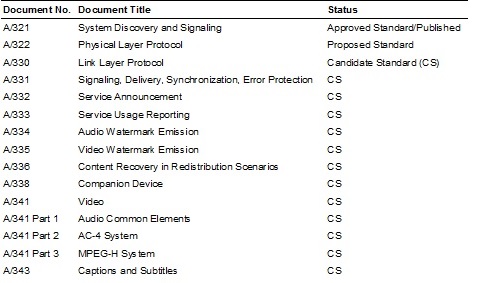ATSC 3.0 Document Status
ALEXANDRIA, VA.—ATSC 3.0 will be a suite of about 20 separate standards. The first one—describing the “entry point” into the physical layer (aka “Bootstrap”)—has been finalized and approved, and is posted on the ATSC web site. Known as A/321, it is the core physical layer specification.
The detailed description of the physical layer is found in A/322, “Physical Layer Protocol.” This is a very large (250+ page) and complex document. A/322 describes the RF/transmission system of the physical layer waveform. It enables flexible configurations of physical layer resources to target a variety of operating modes. The intent is to signal the applied technologies and allow for future technology adaptation. A/322 is currently at the Proposed Standard stage, with final approval expected this summer.
At this writing, more than a dozen other documents that describe various elements of the ATSC 3.0 system are at the Candidate Standard (CS) phase, where implementation experience is gained and the document is expanded and clarified as needed. The bulk of all ATSC 3.0 specifications have been made public for review and trial implementations. All ATSC Candidate Standards can be downloaded from the ATSC web site. See Table 1.

Table 1: ATSC 3.0 Document Status
SPECIFIED PROCESS
Working Draft documents in development include specification of the STL system, optional RF return path, runtime environment, and security provisions. In addition, a document is under development that describes the overall ATSC 3.0 system, and the components necessary to make it work.
Like any standards development organization (SDO), ATSC has a specified process for document development. Fig. 1 illustrates the major steps.
The professional video industry's #1 source for news, trends and product and tech information. Sign up below.

Fig. 1: ATSC document development process
The path taken by a standard from concept through to completion can vary. In general, however, the process is as follows:
1.A Specialist Group (usually with the assistance of a designated ad-hoc group of experts) develops the specification and approves it by consensus, at which point the document is forwarded to the parent Technology Group.
2.The Technology Group votes by ballot to elevate the document to Candidate Standard (CS) for a specified period of time. A two-thirds majority is required for approval. Comments are considered.
3.At or before the close of the CS period, the Technology Group votes by ballot to elevate the document to Proposed Standard. A two-thirds majority is required for approval. Comments are considered.
4.The ATSC Membership votes by ballot to approve the document. A two-thirds majority is required for approval. Comments are considered.
5.The completed document is posted on the ATSC web site as a Standard.
REACHING CONSENSUS
Reaching consensus is a key part of standards development. Consensus requires that under due process procedures, substantial agreement has been achieved among members. Substantial agreement means much more than a simple majority, but not necessarily unanimity.
The timeline for moving a document from one step to the next varies, depending on the document itself. For most of the ATSC 3.0 specifications, a time span of about two years is probably typical. The majority of work occurs during initial document development. After that, the CS phase is probably the second most time-intensive part of the process. The intent of this multi-level approval process is to make certain that the specification is technically correct and addresses the user requirements identified before work began on the project.
Work in ATSC is open to all with a direct and material interest in the work. All ATSC Standards, Candidate Standards, and Recommended Practices can be downloaded at no charge from the ATSC Web site.
Jerry Whitaker is Vice President for Standards Development at the Advanced Television Systems Committee.
For more on this subject, visit our ATSC 3.0 silo.

